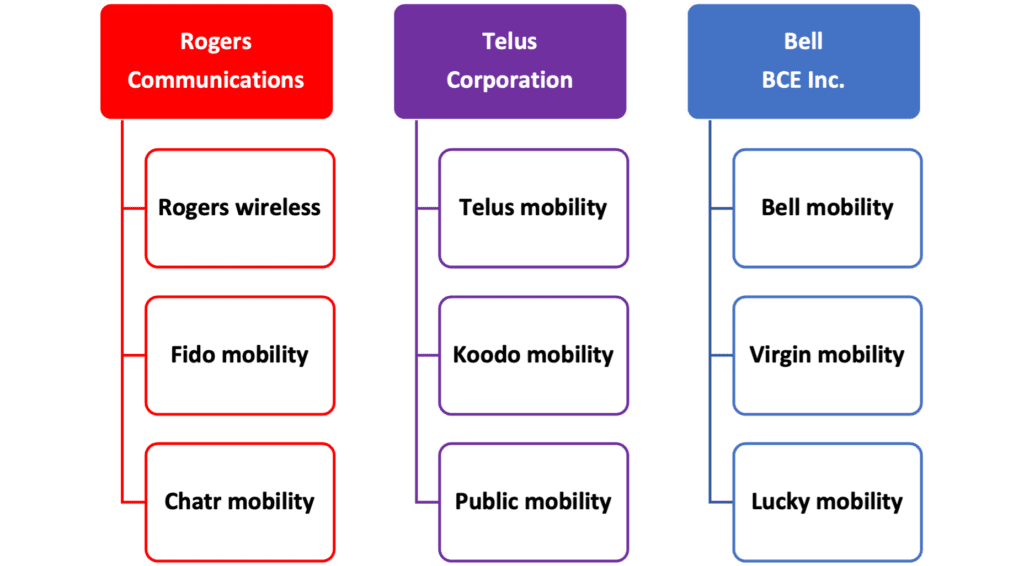
The Big Three: Telecom Service Providers in Canada
Welcome to Canada, newly arrived friends! Across this expansive nation, you’ll find free WIFI widely available in public spaces, shops, and cafes. Consequently, most telecom service providers in Canada don’t offer “unlimited” data plans, which might result in overall telecom costs being slightly higher compared to Asian countries.
Fear not, though, as there are usually discount promotions rolled out by telecom companies in May, and September, as well as during the holiday seasons. If you’re an international student, make sure to stay tuned to your school’s international students center—you might stumble upon special collaboration deals with mobile carriers! Plus, with the highly competitive Canadian telecom market, many providers have done away with contract limitations. If you’re considering a long-term stay, opting for a monthly subscription could be a savvy and convenient choice.
It’s worth emphasizing that Canadians pay keen attention to value for money, leading to diverse market offerings. The so-called Big Three—Rogers, Telus, and Bell—hold significant market shares but only cover less than 30% of the country’s vast terrain. Rest assured, though, urban areas and other densely populated regions generally boast over 99% coverage. When selecting a telecom plan, be vigilant about the coverage areas and roaming restrictions. Smaller providers like Chatr and Public might have limitations, offering service only in specific regions, possibly leaving you without a signal beyond those areas.
I know, it’s a lot to take in, but I hope this guide eases your journey in finding the right telecom service provider in Canada. Wishing you a smooth and enjoyable transition to your new life here!
The Big Three: Brands, Services, and Target Markets
Meet Canada’s big three in wireless service: Rogers Wireless with 10.4 million subscribers, Bell Mobility with 9.8 million, and Telus Mobility holding 9.5 million. Together, they’ve got 86% of the market cornered. But they’re not just about the numbers; they’ve got side brands tailored to different folks and collaborate with the little guys in telecom to make sure customers get great coverage and can pick from cool deals to find what suits them best.

Rogers Wireless
Subsidiary Brands: Fido (targeting youth), Chatr (minors/students, budget-friendly)
Primary Services: Wireless internet, mobile network, home wireless phone, home surveillance, credit cards
Telus Mobility
Subsidiary Brands: Koodo Mobile (targeting youth), Public Mobile (budget-friendly)
Primary Services: Mobile phones, internet, landline, home security, television
Bell Mobility
Subsidiary Brands: Virgin Mobile (targeting youth), Lucky Mobile (budget-friendly)
Primary Services: Mobile phones, internet, television
Service & Coverage Leaders
Rogers, Bell, and Telus offer the best service and high network coverage. They have the highest prices and are suitable for those with enough budget, wanting 10GB or more of high-speed data, especially in remote suburbs.
Youth & Value Focus
Brands like Fido, Virgin, Koodo offer high data choices, suitable for individual plans for young people. Ideal for those with a moderate budget, wanting less than 10GB of high-speed data, with human customer service available. Fido often has the most promotional offers.
Budget-Friendly Options
Chatr, Lucky Mobile, Public Mobile offer reasonable pricing. Suitable for those on a tight budget, unconcerned with customer service or communication quality, mainly for underage students or low-income earners residing in major city areas.
Network Coverage & Reception
Various options depending on the region and your specific needs, from family plans to prepaid cards.
- Best Reception in Western Canada: Rogers (Fido, Chatr), Telus (Koodo)
- Best Reception in Eastern Canada: Bell (Virgin), Rogers (Fido, Chatr)
- Best Coverage in Canada: Rogers (including Yellow Knife aurora borealis viewing locations)
- Suitable for Family Plans, Home Internet, and Phone (Higher Price): Rogers, Telus, Bell
- Suitable for Individual Plans (Budget-Friendly): Fido, Koodo, Virgin
- Prepaid Cards: Chatr
How to Choose a Mobile Plan in Canada
We suggest dividing your selection criteria into a few key areas:
- Budget: How much are you willing to spend?
- Usage Habits: How much data do you need?
- Activity Range: Where do you usually hang out?
Canada is the second-largest country in the world, so even the big telecom giants like Rogers, Telus, or Bell cover less than 30% of the total geographic area. But don’t worry, in the more densely populated cities and towns, there’s a service coverage rate of over 99%.
In addition to nationwide network coverage provided by major telecoms and their subsidiary brands, you should be aware that some smaller Canadian telecom companies have regional restrictions, like Chatr and Public. These companies only offer coverage in specific areas of Canada, meaning you might find yourself without a signal outside these designated regions! So before choosing your telecom plan, it’s crucial to check coverage ranges and roaming restrictions.
That’s the scoop on Canadian telecom. Happy hunting, and welcome to your new home!








